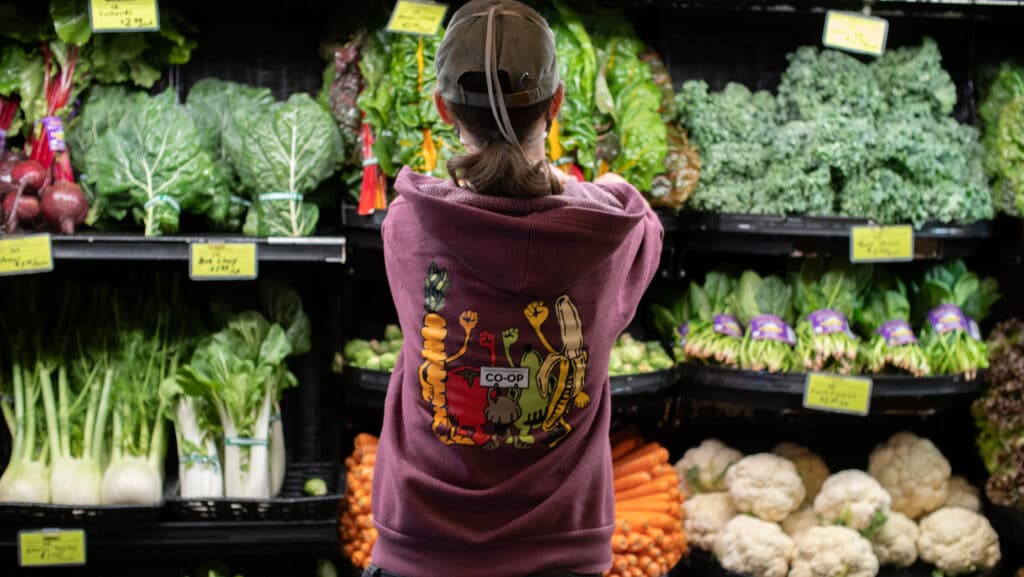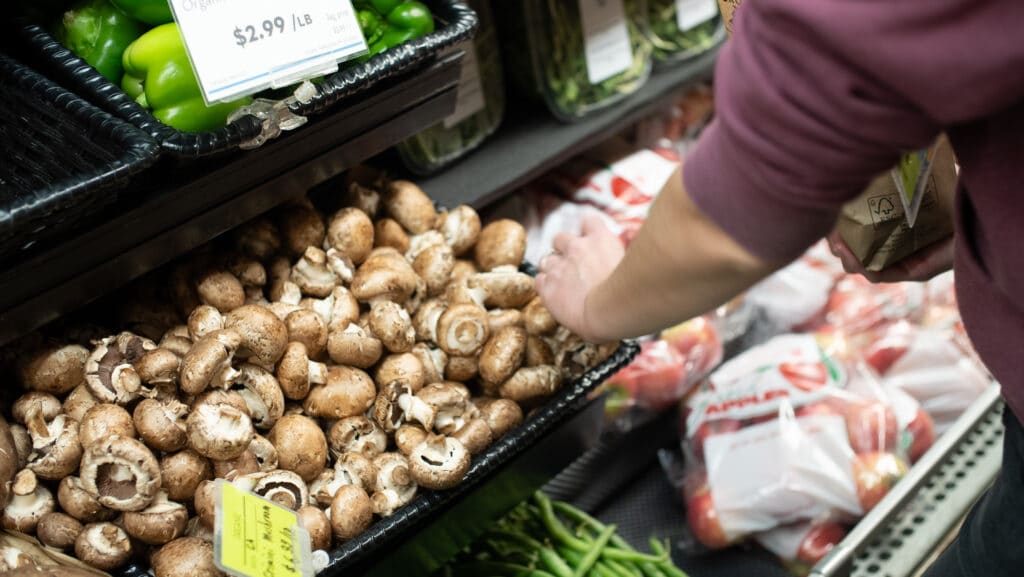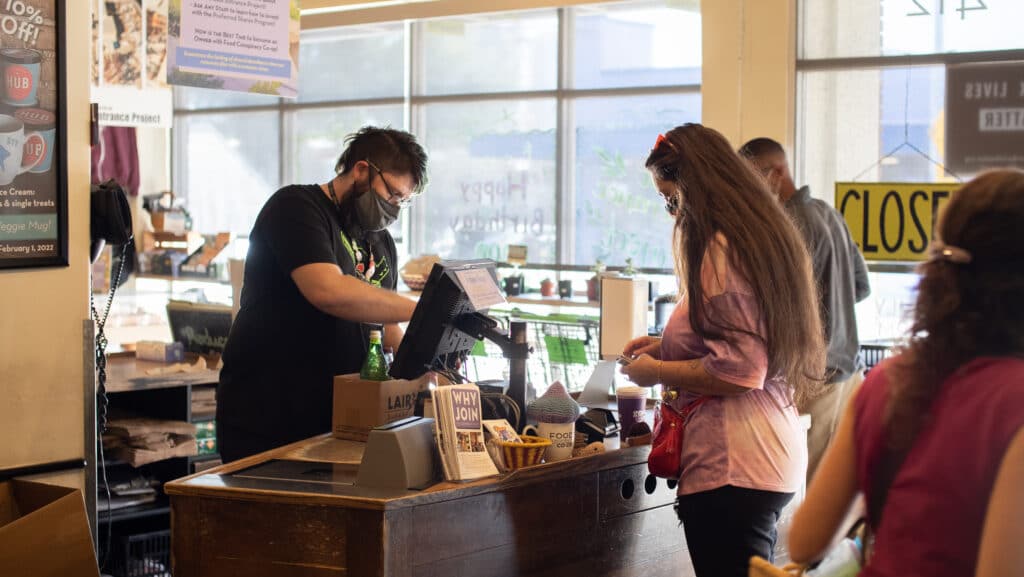Twenty years ago, it was rare—if not impossible—to find organic products in conventional grocery stores. Even the term organic was a buzzword typically found in cosmopolitan locales like New York and San Francisco, as the Whole Foods juggernaut was still two decades away.
This was the food landscape Andrea Buttrick found upon arriving in Tucson at the turn of the millennium, just months away from earning her bachelor’s degree at a small Quaker college.
In her native New Hampshire, Buttrick had grown up around farms, so organic food wasn’t a novelty, just a way of life. But in Tucson grocery stores, she found aisles packed only with processed, preservative-heavy foods—and very few fresh options. That is, until she stumbled upon the Food Conspiracy Co-op.

UNCOVERING THE CONSPIRACY
The shopfront was small, somewhat nondescript, and unremarkable. But when she stepped inside the Food Conspiracy Co-op for the first time, Andrea was transported right back to the New England farms of her childhood.
Figuring it was worth her “hard-earned money” in those tight college days, Andrea became an owner of the co-op, which entitled her to an assortment of fresh organic produce each month. At last, Andrea could eat healthy and support a local business while doing so. Not long after, she decided to work at the co-op, finding herself owner and employee.
Working at the co-op wasn’t just another grocery store experience, as Andrea discovered. The leadership sought to be more than a business, like a community center of sorts. “Grocery and retail can be so mundane and conventional,” Buttrick says. “But the leadership is so visionary, so revolutionary, so capable of turning vision into action.”
“It’s democratically driven, with owners participating in board meetings and voting on the direction of the co-op.”
SUSTAINING THE MISSION
Just a few short years after Andrea was introduced to the co-op, organic products blew up throughout mainstream culture, with the FDA releasing its first organic national standards in 2002. By 2003, organic products were found in nearly three-quarters of all grocery stores, with even large retailers getting in on the action.
As the US changed its attitude toward healthier eating, the Food Conspiracy Co-op waited for the country to catch up. Fifty years since its opening, the co-op remained solid on its 4th Avenue location, still unwavering in its goal of providing access to food “as local as possible, as healthy as possible, with the lowest possible prices.” Most importantly, the Food Conspiracy Co-op kept its cooperative ownership structure, where customers also own a piece of the business.
“The idea was always to have cooperative ownership,” Buttrick says.
HATCHING THE CONSPIRACY
This alternative form of cooperative ownership wasn’t an accident or a clever idea to attract media attention. From the earliest days of the Food Conspiracy, the cooperative structure grew as organically as the food.
In 1971, a conspiracy was afoot in Tucson. In the Old Pueblo, a shadowy group formed a buyer’s club to transport a product rare and desired in the quiet desert town: fresh food.
The effort was led by volunteers who were “paid” fresh produce in return for boxing up and transporting products. Eventually, the operation became popular enough that the group was able to rent a storefront and turn the conspiracy into a business.
At first, the store was run by about 20 employees, all sharing the duties of managing a busy grocery store with a growing clientele. Unsurprisingly, things quickly became difficult to manage and the Food Conspiracy needed to change. They elected a board of directors tasked with developing the vision of the enterprise, then hired a separate management team for the day-to-day operations.
Buttrick says that hiring managers allowed the co-op to “knit together operations and the board.” This freed the board to focus on the co-op’s mission and explore new ways of impacting the community using their cooperative model.
“The cooperative model has been tried and true,” Buttrick says. “It’s the best way to pool resources and energy, and receive an exponential increase in access.”

LOCATION, LOCATION, LOCATION
Leveraging the cooperative model has allowed the co-op to provide affordable, fresh produce to 4th Avenue and downtown, areas that have seen costs skyrocket in recent years. Buttrick says that the co-op’s location has always held a strategic purpose of serving those most in need of fresh food.
“The co-op sits in an area where people bike, walk, and take public transportation,” Buttrick says. “It also means that healthy food options may be less accessible,” since
people without access to a car have a harder time getting to and from a grocery store that may be miles from home.
A recent study by the University of Arizona found that 94,000 Tucson residents live in a food desert, representing about 18% of the city’s population. Food deserts are typically defined as low-income neighborhoods that lack access to nutritious and affordable food.
Buttrick says that “we, the privileged economic classes, have created these food deserts” and have the responsibility to do something about the problem, a task the Food Conspiracy Co-op takes seriously. Although large retailers now regularly stock their shelves with products claiming to be healthy, often the ingredients don’t match the message.
“Eating healthy has become more conventional,” Buttrick says.
“Overall, it’s great to have more awareness, but it can also get away from the message.”
In contrast to large retailers, Buttrick says that the co-op pays special attention to the products they carry, along with every customer or owner that walks through the door. It’s this personalized approach that sets the Food Conspiracy Co-op apart from the large retailers.
“We want to make our customers and owners feel welcome and engaged,” Buttrick says. “We like to call it the “Cheers” model, where everyone knows your name.”
THE CONSPIRACY EXPANDS
As it stands, the co-op now boasts about 2,500 active members, and about 4,000 overall. With membership numbers booming and the team firing on all cylinders, the co-op decided it was time to move forward.
This February marks the beginning of the co-op’s long- awaited expansion, a project decades in the making. “The owners had wanted to expand for 50 years but never found the right opportunity,” Buttrick says. “But now we have the perfect lineup of staff, board, and timing.”
The expansion will add a new entrance on 3rd Ave., along with 2,000 square feet of retail space. Rather than packing the increased area with new products, Buttrick says the space will “let existing products breathe” along with “allowing room for customers to talk with staff.”
In addition to retail space, the expansion will feature a covered entranceway, shaded green space, water and solar harvesting, plus additional meeting and performance areas. To account for increased traffic, the co-op will also add 33 parking spaces, to be made with permeable surfaces and “no black top.” Buttrick says this last point was important to “keep the whole operation sustainable.”

STAYING HEALTHY THROUGH HARD TIMES
The efforts to remain sustainable through all aspects of the business shows the co-op’s dedication to the Tucson community and a desire to be a business that creates solutions. As a result, the co-op continues to attract intense devotion among its owners and employees.
Buttrick says this sense of community has been “especially important” during the COVID-19 pandemic, when the small business community took an outsized hit. Fortunately, Buttrick says that the co-op didn’t “lose one staff member” during the pandemic and hasn’t suffered nearly as much as other businesses whose models are less sustainable and resilient. She credits management with keeping the operation local, which resulted in “less depletion and less empty shelves” during the early days of the pandemic.
For the co-op, running a successful business has meant meeting the call of their community’s needs. By keeping the entire operation local, they’ve been able to respond and deliver not just healthy food, but a healthy lifestyle. This, Buttrick says, can only come from working together. “The more we have collaborative voices, the more likely we are to serve our communities,” she says. “When our money stays local, it’s just that much more powerful.”





